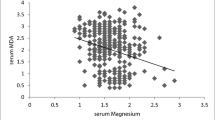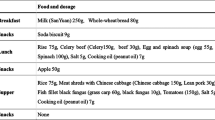Abstract
Background
Fructose intake has increased steadily during the past 2 decades. Fructose, like other reducing sugar, can react with proteins, which may account for aging and cataract formation. Fructose participates in glycation (fructation) and advanced glycation endproducts (AGE) formation some ten times faster than glucose. This study aims to determine the fructose concentration and correlate with antioxidant status in senile diabetic and non-diabetic cataract patients.
Methods
The study included 124 subjects. Of them, 31 were normal senile subjects, 33 were senile diabetic patients without cataract, 30 were senile diabetic patients with cataract, and 30 were senile non-diabetic patients with cataract. The patients were selected on clinical grounds from Eye Ward, Jinnah Postgraduate Medical Centre, Karachi, Pakistan.
Results
Serum fructose was significantly increased (P < 0.001) in senile diabetic patients with and without cataract and senile non-diabetic patients with cataract as compared with senile control subjects. Negative significant correlation was observed between serum fructose and serum total antioxidant status in diabetic and non-diabetic patients with cataract. Positive significant correlation was observed between serum fructose and s-AGEs in diabetic and non-diabetic patients with cataract. Serum total antioxidant status was found to be significantly decreased (P < 0.001) in senile diabetic patients with and without cataract and senile non-diabetic patients with cataract as compared with senile control subjects. Fasting blood glucose, HbA1C and serum fructosamine were significantly increased (P < 0.001) in senile diabetic patients with or without cataract as compared with senile non-diabetic patients with cataract and senile control subjects.
Conclusions
The results indicate that the increased fructose concentration which induces oxidative stress in diabetic and non-diabetic patients with cataract may be a predictor for cataractogenesis.

Similar content being viewed by others
References
Shera S (1998) Prevalence and prevention. Diabetes Dig 12:7–8
Kawasaki Y, Fujii J, Miyazawa N, Hoshi A, Okado A, Tano Y, Taniguchi N (1998) Specific detection of the early process of the glycation reaction by fructose and glucose in diabetic rat lens. FEBS Lett 441:116–120, doi:10.1016/S0014-5793(98)01529-4
Dills WL (1993) Protein fructosylation: fructose and the Maillard reaction. Am J Clin Nutr 58:779S–787S
Suarez G, Maturana J, Oronsky AL, Raventos-Suarez C (1991) Fructose induces fluorescence generation of reductively methylated glycated bovine serum albumin: evidence of nonenzymatic glycosylation of Amadori adducts. Biochim Biophys Acta 1075:12–19
Tagaki Y, Kashiwagi A, Tanaka Y, Asahina T, Kikkawa R, Shigeta Y (1995) Significance of fructose-induced protein oxidation and formation of advanced glycation endproduct. J Diabetes and its Complications 9:87–91
Ding EL, Malik VS (2008) Convergence of obesity and high glycemic diet on compounding diabetes and cardiovascular risks in modernizing China: an emerging public health dilemma. Global Health 4:4–9, doi:10.1186/1744-8603-4-4
Levi B, Werman MJ (1998) Long term fructose consumption accelerates glycation and several age related variables in male rates. J Nutr 128:1442–1449
Chung SS, Ho EC, Lam KS, Chung SK (2003) Contribution of polyol pathway to diabetes-induced oxidative stress. J Am Soc Nephrol 14:S233–S236, doi:10.1097/01.ASN.0000077408.15865.06
Lee AY, Chung SM (1999) Contributions of polyol pathway to oxidative stress in diabetic cataract. FASEB 13:23–30
Jedziniak JA, Chylack LT, Cheng HM, Gillis MK, Kalustian AA, Tung WH (1981) The sorbitol pathway in the human lens: aldose reductase and polyol dehydrogenase. Invest Ophthalmol Vis Sci 20:314–326
Dawczynski J, Strobel J (2006) The aging lens—new concepts for lens aging. Ophthalmologe 103:759–764, doi:10.1007/s00347006-1410-z
Gabir MM, Roumain J, Hanson RL, Bennett PH, Dabelea D, Knowler WC, Imperatore G (2000) The 1997 American Diabetes Association and 1999 World Health Organization criteria for hyperglycemia in the diagnosis and prediction of diabetes. Diabetes Care 23:1108–1112, doi:10.2337/diacare.23.8.1108
Pogell BM (1954) The quantitative determination of fructose with skatole and hydrochloric acid. J Biol Chem 211:143–147
Miller NJ, Rice-Evans C, Davies MJ, Gopinathan V, Milner A (1993) A novel method for measuring antioxidant capacity and its application for monitoring the antioxidant status in premature neonates. Clin Sci 84:407–412
Ono Y, Aoki S, Ohnishi K, Yasuda T, Kawano K, Tsukada Y (1998) Increased serum levels of advanced glycation end-products and diabetic complications. Diabetes Res Clin Pract 41:131–137, doi:10.1016/S0168-8227(98)00074-6
Shah SP, Dineen B, Jadoon Z, Bourne R, Khan MA, Johnson GJ, De Stavola B, Gilbert C, Khan MD (2007) Lens opacities in adults in Pakistan: prevalence and risk factors. Ophthalmic Epidemiol 14:381–389, doi:10.1080/09286580701375179
Aronson D (2008) Hyperglycemia and the pathobiology of diabetic complications. Adv Cardiol 45:1–16, doi:10.1159/000115118
Park YK, Yetley EA (1993) Intakes and food sources of fructose in the United States. Am J Clin Nutr 58:737S–747S
Miyazawa N, Kawasaki Y, Fujii J, Theingi M, Hamaoka R, Matsumoto A, Uozumi N, Teshima T, Taniguchi N (1998) Immunological detection of fructated proteins in vitro and in vivo. Biochem J 336:101–107
Kawasaki T, Akanuma H, Yamanouchi T (2002) Increased fructose concentrations in blood and urine in patients with diabetes. Diabetes Care 25:353–357, doi:10.2337/diacare.25.2.353
Bell RC, Carlson JC, Storr KC, Herbert K, Sivak J (2000) High-fructose feeding of strptozotocin-diabetic rats is associated with increased cataract formation and increased oxidative stress in the kidney. Br J Nutr 84:575–582
Franke S, Dawczynski J, Strobel J, Niwa T, Stahl P, Stein G (2003) Increased levels of advanced glycation end products in human cataractous lenses. J Cataract Refract Surg 29:998–1004, doi:10.1016/S0886-3350(02)01841-2
Johnson RJ, Segal MS, Sautin Y, Nakagawa T, Feig DI, Kang DH, Gersch MS, Benner S, Sánchez-Lozada LG (2007) Potential role of sugar (fructose) in the epidemic of hypertension, obesity and the metabolic syndrome, diabetes, kidney disease, and cardiovascular disease. Am J Clin Nutr 86:899–906
Ahmed FN, Naqvi FN, Shafiq F (2006) Lipid peroxidation and serum antioxidant enzymes in patients with type 2 diabetes mellitus. Ann N Y Acad Sci 1084:481–489, doi:10.1196/annals.1372.022
Yamagishi S, Imaizumi T (2005) Diabetic vascular complications: pathophysiology, biochemical basis and potential therapeutic strategy. Curr Pharm Des 11:2279–2299, doi:10.2174/1381612054367300
Andriollo-Sanchez M, Hininger-Favier I, Meunier N, Venneria E, O’Connor JM, Maiani G, Coudray C, Roussel AM (2005) Age-related oxidative stress and antioxidant parameters in middle-aged and older European subjects. Eur J Clin Nutr 59:S58–S62, doi:10.1038/sj.ejcn.1602300
Hallfrisch J (1990) Metabolic effects of dietary fructose. FASEB J 4:2652–2660
Rajasekar P, Palanisamy N, Anuradha CV (2007) Increase in nitric oxide and reductions in blood pressure, protein kinase C beta II and oxidative stress by L-carnitine: a study in the fructose-fed hypertensive rat. Clin Exp Hypertens 29:517–530, doi:10.1080/10641960701743998
Stanhope KL, Havel PJ (2008) Fructose consumption: potential mechanisms for its effects to increase visceral adiposity and induce dyslipidemia and insulin resistance. Curr Opin Lipidol 19:16–24
Basciano H, Federico L (2005) Adeli k. Fructose, insulin resistance, and metabolic dyslipidemia. Nutr Metab 2:5–11, doi:10.1186/1743-7075-2-5
Sheikh MA, Robb DA (1995) Role of glucose and fructose in diabetic complications. Pak J Bioch Mol Biol 28:153–161
Abou-Seif MA, Youssef AA (2004) Evaluation of some biochemical changes in diabetic patients. Clin Chim Acta 346:161–170, doi:10.1016/j.cccn.2004.03.030
Acknowledgement
This work was financially supported by a Pakistan science foundation grant. We are also grateful to Dr. Wasdev Harani, Head of Department, Eye Ward Jinnah Postgraduate Medical Centre, Karachi, Pakistan for providing human samples.
Author information
Authors and Affiliations
Corresponding author
Rights and permissions
About this article
Cite this article
Gul, A., Rahman, M.A. & Hasnain, S.N. Role of fructose concentration on cataractogenesis in senile diabetic and non-diabetic patients. Graefes Arch Clin Exp Ophthalmol 247, 809–814 (2009). https://doi.org/10.1007/s00417-008-1027-9
Received:
Revised:
Accepted:
Published:
Issue Date:
DOI: https://doi.org/10.1007/s00417-008-1027-9




